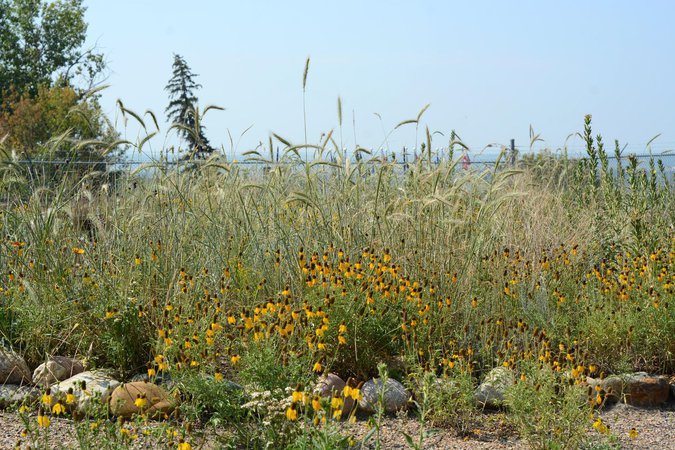
She described Seneca root as “a plant that I believe is getting rarer. I think it’s quite precious on multiple levels, but it’s very much a sacred medicine.”
The garden grew out of an exhibition on women’s roles in Indigenous communities. To create it, the gallery worked with elders Daphie Pooyak and Wes Fineday.
“The idea was to have a place where people could harvest medicine, they could learn about the medicines and children could see what these medicines looked like,” Garven said.
“It was very successful. It was planted by volunteers and then maintained by gallery staff after that, as best as we can maintain it.”
Leah Garven, curator and manager of galleries at the Allen Sapp Gallery, introduces battlefordsNOW’s reporter to the healing garden.
Renewal brings a fresh design
After about a decade, the garden was disrupted by sewer work connected to the trunk vein project.
“The elders explained to us it was time for renewal,” Garven said.
The space was dug up in 2022 and replanted in late 2023.
“Instead of such a strong focus on native plants, the garden has more of an emphasis as a pollinator garden. It has a lot of the same plants in it, so it’s still there, but now there’s been more plants added to attract pollinators.”
Garven said the elders’ decision to renew has proven right.
“It’s wonderful to have a new garden that’s refreshed and the same, much of the same plants, and is going to act as a little beacon to all the pollinators flying through the area,” she said.
Built for pollinators and the prairie
Elizabeth Bekolay, a biologist and garden designer, led the renewal.
“This garden had three or four main parts to it, so there was a bed that was dedicated to kind of short grass prairie species, two beds that were dedicated to mixed grass prairie species and one bed dedicated to the tall grass prairie ecosystem and then a whole bed dedicated to kind of like an example of what an eco-buffer is,” she said.
An eco-buffer is an agroforestry system made up of a dense and diverse mix of native trees and shrubs, designed to replicate the habitat of a natural forest.
Bekolay wanted the redesign to highlight the ecological roles of prairie plants.
“Instead of focusing on human uses or medicinal uses of plants, I focused just on the ecological role of most of these plants,” she said. “Especially since the prairies are like the most endangered ecosystem or one of the most endangered ecosystems in the world.”
A living classroom
The garden now features over 75 species of native prairie plants from across the region, according to Bekolay.
Beds are arranged to represent shortgrass, mixed-grass and tallgrass prairies, each planted to reflect how these species grow together in the wild.
Based on her research, native prairie once supported 30 to 60 million bison before the 1700s. Today, only 8 to 14 per cent of native prairie remains in Saskatchewan, and less than five per cent across North America, making it one of the most endangered ecosystems on the continent.
The garden also includes a medicine wheel bed in the centre, featuring sweetgrass, sage, juniper and bearberry to reflect the original cultural concept for the healing garden.
“We ensured we had those in the middle because that was part of the original intention,” Bekolay said.
Thriving without extra care
All of the plants are perennial or biennial native species that have long co‑existed with local pollinators.
“When I plant a garden and I bring in certain species that might not have been in that area for a long time … tiny insects show up almost immediately when they find the flowers,” Bekolay said.
Garven said the garden is designed to sustain itself.
“It’s been designed so that we don’t water it,” she said.
Bekolay said prairie plants survive Saskatchewan’s dry climate by growing deep roots.
“Our native plants, they’re very deep rooted,” she said. “And then if it gets really, really dry, they might just die back, but they’ll just go dormant.”
As the heart of the garden is to benefit and educate the community, visitors are welcome to harvest plants if they follow proper protocols.
“It’s an offering to the land, usually in the form of tobacco and a prayer, and people should probably personally ask somebody [Indigenous communities] about that protocol,” Garven said.
“But it’s an offering to the land, to Mother Earth, that you’re removing something from the earth with good intentions … and don’t take it all. Leave some for somebody else. Leave some for it to recede.”
Bekolay hopes the garden will eventually be a source of seeds for others to grow pollinator-friendly spaces.
“One thing that I have hoped for this garden that hasn’t really happened very much yet … is that this garden becomes a source of seed for other people that want to do the same thing in their yards,” she said.
—
Kenneth.Cheung@pattisonmedia.com

